Regal sedan remains, as stunning GS hatch
By John Gilbert
When I had the chance to road-test a new Buick Regal Tour-X a few months ago, I was impressed that the stately old General Motors icon had the audacity to build a station wagon, let alone a long and slinky European-style, all-wheel-drive wagon, powered by a turbocharged 4-cylinder engine.
The traditional Regal sedan, we were told, was no more, and the wagon would carry on. Well, not so fast.
I have now had the chance to spend a week with the new Buick Regal GS, which doesn’t look anything like the current Regal midsize sedan, but then, it doesn’t look anything like the Tour-X wagon, either.
Personally, hatchbacks usually make a lot of sense, and I don’t subscribe to the trend of separating hatchbacks from sedans, any more than I don’t criticize others for failing to point out that all SUVs must also be identified as hatchbacks. Regardless, I would have to say that the new Regal GS is the best-looking car from Buick since…well…maybe ever!
That comes from someone who was never a dedicated Buick fanatic, but who also thought that the current Regal was an outstanding car and the first Buick I can recall that could ignite buyer’s temptation in me. When I learned that previous Regal was a U.S. branded model of a new German Opel Vectra, its progressive leap upward made more sense. It was even made in Europe for a while, while Buick geared up to build it in North America.
Now we find out that if the newest model of the Buick Regal germinated (Germanated?) from the new model Opel Insignia, a longer and classier car than the Vectra/Regal, but one with smoothly aerodynamic lines that exude grace and streamlined speed. General Motors has sold off Opel, which made me curious what Buick would do without its trusty German models, but now we find out that in their separation, Opel promised to keep building cars for Buick, and the Regal GS is a version of the new model, stretched and fitted with a hatchback over its generous cargo area. That allows for a sleek, fastback silhouette.
Parked downtown in Duluth or Minneapolis, we were surprised at how much attention the new Regal GS generated. People would stop on the sidewalk and wait until we returned to the car to quiz us about it. Generally, they would leave, shaking their heads in a real-life version of those inane “Real people, not actors” GM commercials, and mutter things like, “That can’t be a Buick,” or “Sure doesn’t look like a Buick.”
Buick should take note of the accolades, because they are uncommon these days, and comparatively unprecedented for Buick. But valuable.
The bright red Regal GS test car has a neat grille, and the swept-back lines come together in a well-styled rear end, as well. As a 4-door, it’s actually a 5-door with the hatch, but we don’t care, despite the reluctance U.S. buyers have for hatchback cars, as though the word itself is objectionable.
Not that the Regal GS is small. It is 192.9 inches long, sitting on a 114.4-inch wheelbase, and it weighs a comparatively hefty 4,270 pounds. Much of that can be attributed to the all-wheel drive.
The Regal GS has a base price of $39,990, which is rather stiff, and the test car was loaded enough to show $44,115 as the bottom line.
I’m an advocate of choosing a turbo 4-cylinder rather than a larger V6 if it will do sufficiently, because of obvious advantages in fuel economy, but a lot of U.S. buyers want their V6es, so the Rebel GS comes armed and dangerous with GM’s corporate workhorse 3.6-liter V6, which easily powers all four wheels, and perhaps can tow just about anything.
The 3.6 churns out 310 horsepower at 6,800 RPMs, and 282 foot-pounds of torque at 5,700 revs. The 9-speed automatic transmission shifts surely and efficiently, and is explained as an “active twin-clutch” transmission. In a Buick? No kidding?
There is a mode switch, and we drove almost exclusively in the sport setting, which wasn’t harsh, and helped stability with much-appreciated tighter steering and firmer suspension.
It wouldn’t be a Buick without considerable doses of comfort, and the Regal GS has very comfortable and supportive front bucket seats, and also comfortable rear seats. The rear seats deserve extra merit, because they are set into a space that is, in a word, huge. With the front buckets set back as far as I would set them as a 6-foot driver, there is a lot of headroom and enormous leg and foot-room in the rear.
The car came equipped with Continental tires mounted on 19-inch alloy wheels, and the size of those tires may have helped the Regal GS handle to near-sporty-sedan standards, although they did seem to cause more than a little noise from Duluth’s minefield-like street irregularities.
Changing from the Regal wagon’s turbo 4 to the Regal GS’s only-choice V6 takes a hit in fuel economy, although an EPA estimate of 19 city and 27 highway is obtainable and isn’t bad for a big, heavy, all-wheel-drive car. But if the turbo 2.0-liter 4-cylinder gives up some drag-racing potential to the 3.6 V6, its performance is certainly adequate, while its fuel economy would be at least 5 more mpg on the highway.
With all its styling grooves and contours, I had trouble deciding which angle of the Regal GS I liked best, and it turned out to be pretty much a tie. Pick an angle, any angle, and you’ll appreciate the car’s appearance.
That brings us back to the old cliche from decades-past ad campaigns: “Wouldn’t you really rather have a Buick?” For the first time in a long time, maybe ever, I can say the answer could be a decisive “Yes!”


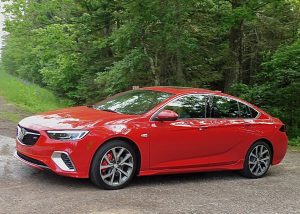
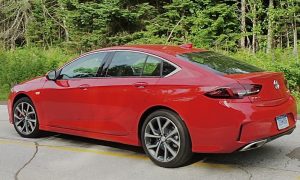
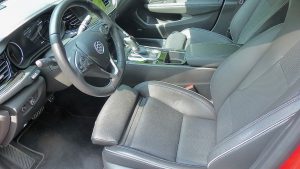
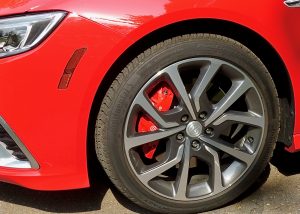
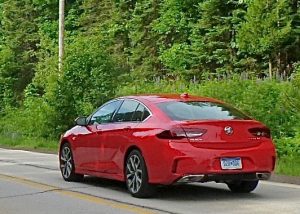
 John Gilbert is a lifetime Minnesotan and career journalist, specializing in cars and sports during and since spending 30 years at the Minneapolis Tribune, now the Star Tribune. More recently, he has continued translating the high-tech world of autos and sharing his passionate insights as a freelance writer/photographer/broadcaster. A member of the prestigious North American Car and Truck of the Year jury since 1993. John can be heard Monday-Friday from 9-11am on 610 KDAL(www.kdal610.com) on the "John Gilbert Show," and writes a column in the Duluth Reader.
John Gilbert is a lifetime Minnesotan and career journalist, specializing in cars and sports during and since spending 30 years at the Minneapolis Tribune, now the Star Tribune. More recently, he has continued translating the high-tech world of autos and sharing his passionate insights as a freelance writer/photographer/broadcaster. A member of the prestigious North American Car and Truck of the Year jury since 1993. John can be heard Monday-Friday from 9-11am on 610 KDAL(www.kdal610.com) on the "John Gilbert Show," and writes a column in the Duluth Reader.